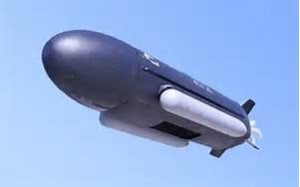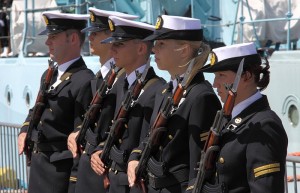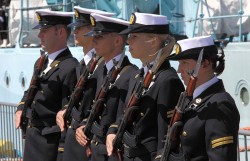C APT Dan Moore, USN Ret, joins us for the first of his monthly series on naval leadership, “More with CAPT Moore.” In today’s episode, we discuss the education of 21st-century naval leaders by discussing examples from the present and past, such as GEN Mattis, LT Sims, and ADM Nelson. Some of the set-up and helpful readings are found in an earlier introduction article. Enjoy our newest episode of Sea Control, “More with CAPT Moore” (Download).
APT Dan Moore, USN Ret, joins us for the first of his monthly series on naval leadership, “More with CAPT Moore.” In today’s episode, we discuss the education of 21st-century naval leaders by discussing examples from the present and past, such as GEN Mattis, LT Sims, and ADM Nelson. Some of the set-up and helpful readings are found in an earlier introduction article. Enjoy our newest episode of Sea Control, “More with CAPT Moore” (Download).
Drone Motherships – In the Sky!
We thought we’d treat you to some light reading for Friday as many are finishing up their vacations or short work weeks.

In a piece in mid-December, our partner site NavalDrones detailed the U.S. Navy’s solicitation for an unmmaned aerial vehicle (UAV) that incorporates Magnetic Anomaly Detector (MAD) sensors. As the article notes, this capability is useful for finding submarines as it “detects changes in the earth’s magnetic field caused by a large metal object” such as yon u-boat. What is perhaps most interesting about the solicitation is that it calls for the UAVs to be expendable and launched from a P-8A Poseidon.
The concept of aerial motherhips is by no means new – one only need look back to the glory days of zeppelins with biplane detachments, or to the helicarrier in the recent movie The Avengers to get a sense of the breadth of idea. And the solicitation for the Poseidon doesn’t mark the first go at aircraft-launched UAVs:
In 2009, an expendable sonobuoy tube-launched UAV called Coyote was tested out a NOAA’s WP-3D Orion under an Office of Naval Research. A less successful small business grant was awarded to Lite Machines to modify its Voyeur UAV for sonochute launch.

Despite this, more attention is focused on surface and subsurface vessels playing the roles of motherships than aerial drone motherships. DARPA caused a stir earlier in 2013 by announcing the start of a UUV mothership program, named in a not-at-all-sinister fashion “Hydra,” that would be capable of launching embarked UAVs and UUVs, while Coastal Riverine Group-1 got the manned Coastal Command Boat UUV-launching mothership. Elsewhere, debate and intellectual energy is starting to explore the interplay of manned, unmanned, and autonomous aircraft and the tactical possibilities their combinations can provide.
Less attention has been paid to aerial motherships as the constant and exploring the pros and cons of using any of the following as variables:
1. The mission sets of the UAVs and how they would interact with other platforms.
2. Launching non-expendable UAVs.
3. Launching USVs or UUVs.
4. Motherships that are purpose-built (as opposed to ad-hoc such as the Poseidon).
5. Motherships that are themselves unmanned or autonomous.
6. Lighter-than-air (e.g. blimp) craft vs propeller or jet craft.
In many of these combinations the pros will be outweighed by the cons, but it’s possible there are some winning, creative combos worth discovering. An upcoming issue of USNI’s Proceedings and a week at CIMSEC will be dedicated to naval drones and drone tactics. In the latter I hope to explore these variables in more detail. As I’ve likely missed some salient points I look forward to incorporating your feedback.
LT Scott Cheney-Peters is a surface warfare officer in the U.S. Navy Reserve and the former editor of Surface Warfare magazine. He is the founding director and vice president of the Center for International Maritime Security (CIMSEC), a graduate of Georgetown University and the U.S. Naval War College, and a fellow with the Truman National Security Project.
The opinions and views expressed in this post are his alone and are presented in his personal capacity. They do not necessarily represent the views of U.S. Department of Defense or the U.S. Navy.
Poland’s New Year Defense Resolutions
 Tomasz Siemoniak, Poland’s Minister of Defense, was asked by the Polish web site “All the Essentials” what he considers the key ideas for 2014. This made for a very short list, but there are some interesting details. The main points he raised are:
Tomasz Siemoniak, Poland’s Minister of Defense, was asked by the Polish web site “All the Essentials” what he considers the key ideas for 2014. This made for a very short list, but there are some interesting details. The main points he raised are:
1. Still the United States! Despite many talking about the decline of American power and influence, Mr. Siemoniak believes this view premature and that Washington will remain a center for setting global security trends. He adds, however: “hopefully without further pivots and resets.” To be sure, U.S. presence in Europe remains crucial for Poland.
2. Cyber Defense. Siemoniak’s observations that effective cyberattacks can send victims directly to the Stone Age are not without a sense of humor. But that is perhaps the right tool in what he believes necessary-raising awareness among decision makers, the military, the press, and ordinary citizens. The storm caused by Snowden resulted in Sea State 1 in Poland. “Hard compromises between security and privacy are unavoidable.”
3. How Many Divisions? The message is that we need to diverge from the old paradigm of troop numbers, equipment, and the talents of commanders in determining the robustness of a state’s security. The economy, culture attractiveness, energy resources, and “even people ready to defend on Twitter our arguments in English or Russian” are important ingredients of a country potential.
4. Polish Fangs. This literary expression describes a shift in Poland’s security strategy that occurred last June. The elements of conventional deterrence form a basis for the armed forces modernization plan. The concept is a bit fluid and contains some elements of A2/AD, but despite modern acronyms the roots of the strategy can be traced to the classic book of B.H. Liddell Hart, Strategy:
The acquisitive state, inherently unsatisfied, needs to gain victory in order to gain its object – and must therefore court greater risk in the attempt. The conservative state can achieve its object by merely inducing the aggressor to drop his attempt at conquest – by convincing him that “the game is not worth the candle.”
2013 was not a bad year for the Polish Armed Forces, but this short list of ideas demonstrates how the concepts of national security and defense evolved and becomes ever broader.
Przemek Krajewski alias Viribus Unitis is a blogger In Poland. His area of interest is the context, purpose, and structure of navies – and promoting discussion on these subjects in his country.
Education of the 21st Century Naval Commander: More with CAPT Moore
 We’re looking for YOUR questions and input!
We’re looking for YOUR questions and input!
CAPT Moore (USN Ret), CEO of Small Unit Aviation LLC, is joining us for a regular installments on Sea Control based on his “Breakout Naval Leadership” talk at the Defense Entrepreneurs Forum. We’re calling it “More with CAPT Moore”.
His talks will first center around the foundations, content, and process of decision-making. Our first installment will be “The Training and Education of the 21st Century Naval Commander.”
The podcast will start with an opening definition on methods of internal control: operational and tactical.
It will be followed by a discussion on leadership traits of successful mission commanders. CAPT Moore initially suggested the examples of Nelson, the Battle of Jutland, LT Sims, and Gen Mattis but is open to more suggestions and questions from online
We will close out by considering integrity, trust, appreciation, and Leadership.
CAPT Daniel Moore, USN (Ret) spent 29 Years Active Duty as a naval aviator, including VFA squadron command. He has spent 7 years in the aerospace industry. He holds a BA in History from Northwestern University and is a former Professor of Naval Science.
CAPT Moore has kindly provided a list of readings that have informed his perspective on this topic. As we’re always looking for new reading at CIMSEC:
Naval Doctrine Publication 6 — Naval Command and Control
Andrew Gordon’s The Rules of the Game
John R. Boyd’s Organic Design for Command & Control
George Gilder’s Knowledge and Power
Send us your comments and ideas for this podcast! We’ll go through questions sent to nextwar@cimsec.org and those posted in the comment section below.



